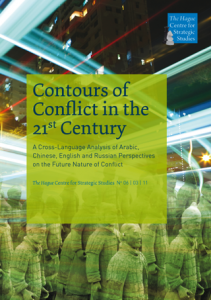Worth a read. Interesting report based on innovative research method. From the Hague Centre for Strategic Studies.
Report: Contours of Conflict in the 21st Century
EXTRACT from Overview:
In gaining a better understanding of the future nature of conflict, it is therefore of the utmost importance to go beyond the traditional Western (English) language domain experts, and include views from regions across the world. The main purpose of the Future Nature of Conflict project is therefore to map and analyze global perspectives about the future nature of conflict published over the last two decades across four language domains – Arabic, Chinese, English and Slavic.

Phi Beta Iota: Finally! For years we have talked about the need to do multi-lingual perspectives and statements (e.g. charting Chinese, Vietnamese, Philippine, and Australian statements on the Spratley Islands going back 200 years). The protocol developed by this team must be –along with M4IS2–the future of strategic dialog, policy, acquisition, and operations. Any intelligence community that is unable to do this for any issue, any question, may as well go out of business.
Reading through the report is a real pleasure, with all sources being spelled out in footnotes that are actively linked to the original sources. This is a marvelous gift to scholars and practitioners at multiple levels.
A few highlights:
Chinese and Russians read all the English stuff, the English thinkers are out of touch–completely–with Chinese and Russian original works.
Special operations, remote, and information operations now co-equal if not superior to conventional armies as future options.
Strategic resource scarcity a primary driver for the Chinese. In Middle East, water wars between Israel and the Arabs and between Egypt and North Africa are a major aspect of future conflict from Arab point of view.
Chinese are non-alignment power, do not think in terms of coalition operations. Russians are the most committed to state on state conventional armies. Arabs, at least in writing, are mired in the present.
Range of actors, including complete spectrum of non-state actors, will challenge status quo intelligence and force structure.
CONTEXT is emerging as a new level of thinking higher than strategic.
“Rules of the Game” will change radically, challenging status quo intelligence and force structure.
Persistent pervasive conflict along a full spectrum can be anticipated absent.
In the English language, Colin Gray, Steve Metz, Ralph Peters, and Bob Scales are all cited. An appendix provides English-language quotes from all four language groups across all of the attributes.
If there is a small criticism, it is that the nature of the project precluded capture of the literature, for example in Chinese, that focus on “war by other means.” It is not correct to say that the Chinese are not focused on political and economic warfare based on sources from the traditional military schools.
This report is worthy of very broad attention across the war colleges. It should immediately be extended in two ways: first, to include Brazil, India, and Indonesia in the orginal protocol; and secondly, expanded to add the literatures in all seven languages for political, socio-economic, ideo-cultural, and techno-demographic conflict. A study of population and education policy, for example, across all seven major actor groups, could be startling.
Read original report (PDF 256 pages)



